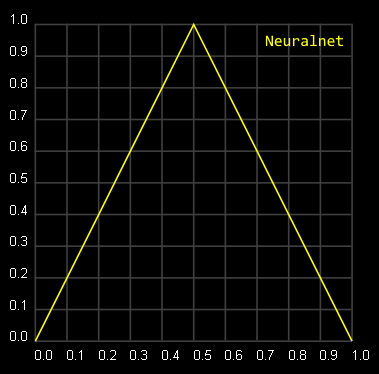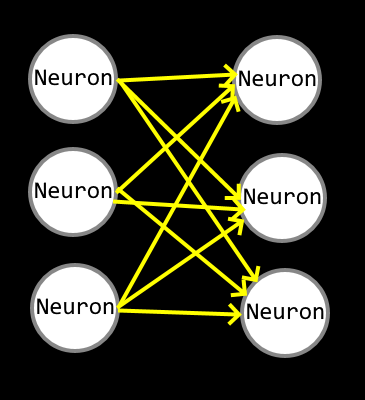Artificial Neural Network's
by Ethan Alexander Shulman (June 19, 2021)
In this article I'm going to describe artificial neural networks as used in software today. The
history of artificial neuralnets has gone through various stages and it could be helpful to research early models like the
perceptron. Commonly called a neuralnet, artificial neural networks
are an attempt to simulate biological neurons in electronics or software. The main feature being the ability to adapt and optimize towards meeting
a goal or more specifically matching desired outputs to inputs. Let's begin by inspecting the inner parts of a artificial neural network
and then we will walkthrough how to program a basic neuralnet in Javascript.
Simulation
 |
This next diagram is the network were going to simulate as an example. The simulation involves calculating the next layers neuron state values
by summing all connected neuron states multiplied by weight scalars(dot product) as well as a constant bias. That summed value is passed through an
activation function like tanh(x) or max(0,x) which allows advanced logic to be calculated. In this example were going to be using max(0,x)
for all our hidden and output neurons, commonly called rectifier linear unit(RELU).
|
Let's begin writing our simulation code, were simply going to write some Javascript to run in your web browsers console. Since our network
has 1 input and 1 output were going to write it as a function that takes in a input parameter and returns the network output. Below we will setup
our function and initialize the constant weight and bias variables.
var hiddenBias0 = -2, hiddenBias1 = 0, outputBias = 0,
weight0 = 4, weight1 = 2, weight2 = -1, weight3 = 1;
function neuralnet(input) {
var output;
return output;
}
Given the process above, first we calculate hidden0 and hidden1 using input and then we calculate output using hidden0 and hidden1. Below you
can see our finished neuralnet simulation function and a test which prints the neuralnets output in the console.
var hiddenBias0 = -2, hiddenBias1 = 0, outputBias = 0,
weight0 = 4, weight1 = 2, weight2 = -1, weight3 = 1;
function neuralnet(input) {
//calculate hidden layer from input
var hidden0 = Math.max(0, input*weight0 + hiddenBias0),
hidden1 = Math.max(0, input*weight1 + hiddenBias1);
//calculate ouput from hidden
var output = Math.max(0, hidden0*weight2 + hidden1*weight3 + outputBias);
return output;
}
for (var x = 0; x < 1.01; x += 0.1) console.log(x.toFixed(2)+"(X) - "+neuralnet(x).toFixed(2)+"(NN)");
 |
To run the code open your web browser console either by pressing F12 or selecting 'Inspect Element' in the menu and open the 'console' tab.
Copy the code above, paste it into the console and press enter to run it. After running it you should see the following output in your console.
0.00(X) - 0.00(NN)
0.10(X) - 0.20(NN)
0.20(X) - 0.40(NN)
0.30(X) - 0.60(NN)
0.40(X) - 0.80(NN)
0.50(X) - 1.00(NN)
0.60(X) - 0.80(NN)
0.70(X) - 0.60(NN)
0.80(X) - 0.40(NN)
0.90(X) - 0.20(NN)
1.00(X) - 0.00(NN)
If you graph these values you will notice our neuralnet is plotting a triangle wave!
|
Learning
Above we established what an artificial neural network is made up of and how to simulate one. But we only ran a fixed neuralnet that had
preset weights and biases, the real challenge is programmatically determining the weights and biases to match our desired goal. This is
commonly called
learning, training, optimizing or evolving.
The many names for the process come from the variety of ways there are to build the weights and biases. The big popular method that has made
neuralnetworks so popular is called
gradient descent and is built off
automatic differentiation. Another family of methods is
genetic algorithms.
Neural network learning is a giant topic and I will cover it in more depth in a later article.
If you have any questions feel free to reach out to me at xaloezcontact@gmail.com.


